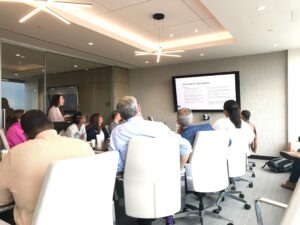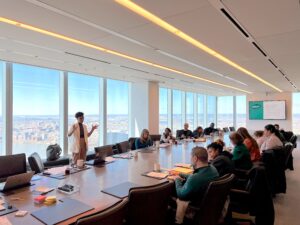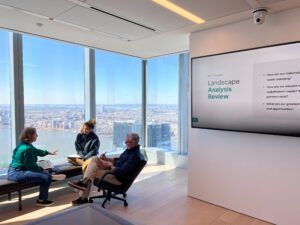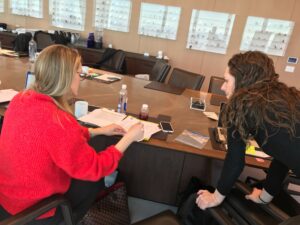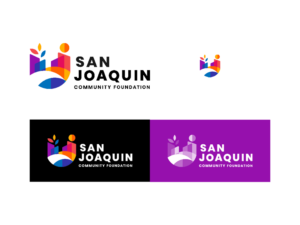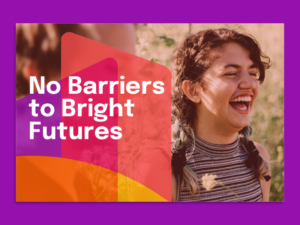Social Impact Consulting for Nonprofits
Mission-driven organizations exist to tackle the world’s most complex challenges, and social impact consulting helps them do that work more efficiently. Explore the sections below to learn how nonprofits, foundations, associations, government entities, and philanthropists work with social impact consulting firms to better achieve their goals:

What is Social Impact Consulting?
Social impact consulting allows community-focused organizations to gain nuanced insights and strategic guidance about reaching their unique goals. The most effective social impact consulting works the same way the most effective social solutions do – by taking an integrated approach. Social impact consulting empowers organizations to optimize their internal capacity by combining strategy, branding and communications, and program design.
Amplify Your Impact with an Integrated Approach
Empower your team with useful information about how to apply a consistent vision to improve results, including real-world examples, best practices, and practical takeaways. View Full Webinar >>
Take Our Free Self-Audit to Know Where You Stand
Mission-driven organizations are experts at driving external change. Social impact consulting improves their internal capacity to do that work.
5 Benefits of Social Impact Strategy Consulting
Hiring a third-party to support your organization’s mission is an investment. You may have questions about working with a consultant for valid reasons, including:
- Will hiring a social impact consultancy be worth the cost? Social impact organizations work within funding restraints imposed by government agencies, donors, and the realities of their sector. Does hiring a third party fit in the budget?
- How can we understand if a social impact agency’s values align with ours? The nature of being a mission-driven organization is having a mission. Not every consultant may buy into your guiding vision and values.
- What role will a consultant play in our work? In other words, what does a consultant actually do? As a social impact organization, it’s important to partner with an agency that respects and values your expertise.
To help you answer these questions, take a look at the benefits you can expect to experience by engaging in a social impact consulting process.
Some executive leaders of nonprofits can be so passionate about their work and focused on their priorities, it becomes difficult for them to understand or even expect that anyone else in their organization has questions. In reality, mission-critical knowledge is often siloed within leadership, resulting in a disconnect across organization teams. Social impact strategic planning anticipates these types of challenges and supports organizations as they identify where to look and who to ask to achieve these unifying outcomes:
- A collectively owned, actionable growth strategy
- Staff and leadership investment in common goals
- Engaged partners and community members
“It’s not uncommon for amazing nonprofits of all sizes to occasionally get stuck. It happens for different reasons – strained internal capacity, outdated branding, disjointed marketing, unsustainable data practices… A strategic planning process is a powerful way to get answers that improve outcomes across the organization and set you up for a new story or innovation opportunity.”
 ANNIE CRANGLE
ANNIE CRANGLE
Partner, Organizational Strategy | Friday
A clear mission and vision are foundational, but they can only set the stage. Action requires the time-consuming and nuanced process of setting realistic goals and defining the exact steps needed to reach them. Consulting firms take the load off of their partners by using a variety of information-gathering methods, from workshops and focus groups to stakeholder interviews and market research, to identify the right steps forward and how to track progress. Allowing a strategy firm to lead this process will result in benefits like these:
- A roadmap to adapt or expand mission-critical programs
- Improved talent pipeline and plan for leadership succession
- Strengthened positioning for fundraising
“A strategic plan is a lot more than an organizational playbook. It’s also the foundation for a compelling brand and communications strategy. The more we understand how an organization’s strategic, revenue, and program goals are changing, the more we can develop grounded storytelling that’s viable for the long term.”
 ELIZABETH CAMERON
ELIZABETH CAMERON
Partner, Brand & Communications | Friday
At their core, mission-driven organizations are interdependent on the communities they support. It’s rare that any nonprofit in the social sector works with a single audience. For example, organizations in higher education must understand post-secondary institutions, students, workforce leaders, and policymakers to address their most pressing issues. Nonprofits that support environmental justice must be connected to families, lobbyists, grassroots organizations, and even trade associations to move their goals forward. A crucial element of social impact strategy consulting is audience research, which results in the following foundational elements of brand and communications:
- A unique, audience-centric value proposition
- Differentiation from competitors in the same sector
- Confident stakeholders motivated to engage with your brand
“Brand and communications only work when they’re integrated. Energizing messaging and visuals are great but won’t produce the results you’re looking for if you don’t get that branding in front of the right audiences. Communications move the story to the people ready to move.”
 KATE VAULTER
KATE VAULTER
Director of Communications | Friday
Understanding your audience is great. Inspiring your audience to answer your calls to action is even better. Developing a moving brand through creative messaging and visual identity is challenging but essential work nonprofits must pursue to support ecosystems of change. However, most nonprofits do not have (and are not designed to be) brand, communications, or marketing teams. Working with a social impact consultant equipped with a creative team allows nonprofits to focus on their missions while telling stories that reach these brand and communications goals:
- Strategic and moving calls to action
- Meaningful communications tactics that drive engagement
- Brand recognition where it matters most
“Designing a brand’s visual identity is a deeply personal process. We engage in a discovery process of strengths, hopes, and strategic goals and work to tell that story as succinctly as possible through symbols and visual language. Great design tells the story of a brand, its mission, and its connection to its audience’s identities and motivations with the power and finesse of a masterfully written piece of music.”
 JOEY PONCE
JOEY PONCE
Partner, Lead Designer | Friday
The leaders of nonprofit organizations will be the first to say that problems, like people, evolve. Whether the challenges themselves or the ways they are perceived have changed, social impact organizations with longevity will need to change, too. The social impact consulting process gives organizations a unique opportunity to identify emerging opportunities, revisit old programming, and design solutions that are more equitable and efficient than what was previously possible. Tangible benefits organizations can expect to experience as a result of working with a consultant include:
- Deepened program and service impacts
- Enhanced framework for testing and optimizing ideas
- Solutions co-designed with impacted communities
“Program design is the bridge between intent and impact. It’s great to have lofty goals – but if your programs are hard to navigate, you won’t drive the impact you want. Achieving that takes refining and inventing new and better ways to deliver value to the people you care about.”
 AUSTIN DANNHAUS
AUSTIN DANNHAUS
Partner, Program Design | Friday
What To Expect From a Social Impact Consultant
You should expect your social impact consulting firm to be experienced in and passionate about the social sectors where you drive change. At Friday, we focus on the three areas that support meaningful learning, equitable work, and healthy relationships:

EDUCATION
Rethinking traditional systems, creating new learning experiences, and ensuring the promise of quality education

ECONOMIC OPPORTUNITY
Expanding and designing new interventions for marginalized communities from workforce development to values-based banking

COMMUNITY DEVELOPMENT
Strengthening vibrant, inclusive communities alongside nonprofits, local stakeholders, and governmental entities
What Social Impact Consultants Actually Do: 3 Examples
Develop strategic plans that adapt to and sustain organizational growth.
Friday worked closely with Harlem Lacrosse’s leadership and distilled this growing, national organization’s vision, mission, values, and approach into a compelling theory of change. We identified the most effective, sustainable, and human-centered ways Harlem Lacrosse could live out its purpose and grow with its expanding community.
Harlem Lacrosse left this social impact strategic planning process with a clarified:
- Theory of change
- Strategic plan framework
- Growth pathways map
- Implementation and progress monitoring plan
Design human-centered programs that accelerate and deepen positive impact.
Friday translated San Joaquin Community Foundation’s new strategic vision into compelling brand messaging bolstered by a new visual identity, website, and communications strategy designed to engage diverse community members.
San Joaquin left this brand process with a refreshed:
- Brand strategy and messaging framework
- Brand identity, collateral, and website
- Communications and community engagement plan
Build brands that reflect and invite their communities to shape a more equitable future.
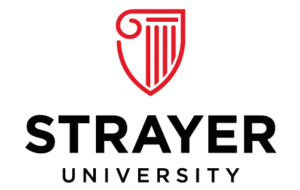
Friday worked with Strayer to completely redesign the conventional model for online learning. Together, we built an Introduction to Business course around storytelling and problem solving rather than lectures and recitation. The resulting course was so successful, Strayer used it to apply this story-driven curricular approach to additional courses.
Strayer left this program design process with new:
- Student-centered course content and sequencing
- Vision and program mapping for student support services
Is Social Impact Consulting Right For Your Organization?
Even if the benefits seem worth the investment, the question remains: “When is the right time to work with a social impact consultant?” Here are a few indicators that suggest taking the leap:
- Rapid growth. If your organization has experienced an accelerated growth of partners, sites, programs, or internally, it’s likely that your strategic plan, storytelling, and programs need to adapt to reflect the change.
- Growth declines. Organizations that experience sustained disengagement from their audiences, internal turnover, and decreased funding may feel the most resistant to investing in a consultant. However, the external support social impact consultants provide can powerfully redirect a struggling organization’s trajectory.
- External change. Social challenges and solutions are constantly evolving, and some organizations may find themselves struggling to keep up. Shifts in your competitor, socio-political, and community landscapes merit a cohesive strategic response.



